PDMS Microlenses for Focusing Light in Narrow Band Imaging Diagnostics
Abstract
:1. Introduction
2. Design and Simulations
2.1. Microlens Design
2.2. Microlens Optical Simulation
3. Microlens Fabrication
4. Results and Discussion
4.1. Microlens Transmittance
4.2. Microlens Optical Characterization
5. Conclusions
Author Contributions
Funding
Acknowledgments
Conflicts of Interest
References
- Mizuno, H.; Gono, K.; Takehana, S.; Nonami, T.; Nakamura, K. Narrow band imaging technique. Tech. Gastrointest. Endosc. 2003, 5, 78–81. [Google Scholar] [CrossRef]
- Kuznetsov, K.; Lambert, R.; Rey, J.F. Narrow-Band Imaging: Potential and Limitations. Endoscopy 2006, 38, 76–81. [Google Scholar] [CrossRef] [PubMed]
- Silva, M.F.; Rodrigues, J.A.; Ghaderi, M.; Goncalves, L.M.; de Graaf, G.; Wolffenbuttel, R.F.; Correia, J.H. NBI Optical Filters in Minimally Invasive Medical Devices. IEEE J. Sel. Top. Quantum Electron. 2016, 22, 1–7. [Google Scholar] [CrossRef]
- Atreya, R.; Neumann, H.; Neufert, C.; Waldner, M.J.; Billmeier, U.; Zopf, Y.; Willma, M.; App, C.; Münster, T.; Kessler, H.; et al. In vivo imaging using fluorescent antibodies to tumor necrosis factor predicts therapeutic response in Crohn’s disease. Nat. Med. 2014, 20, 313–318. [Google Scholar] [CrossRef] [PubMed]
- Joshi, B.P.; Wang, T.D. Gastrointestinal imaging in 2015: Emerging trends in endoscopic imaging. Nat. Rev. Gastroenterol. Hepatol. 2016, 13, 72–73. [Google Scholar] [CrossRef] [PubMed]
- Dung, L.-R.; Wu, Y.-Y. A Wireless Narrowband Imaging Chip for Capsule Endoscope. IEEE Trans. Biomed. Circuits Syst. 2010, 4, 462–468. [Google Scholar] [CrossRef] [PubMed]
- Micic, D.; Semrad, C.E. Small Bowel Endoscopy. Curr. Treat. Options Gastroenterol. 2016, 14, 220–235. [Google Scholar] [CrossRef] [PubMed]
- Qureshi, W.A. Innovation: Current and future applications of the capsule camera. Nat. Rev. Drug Discov. 2004, 3, 447–450. [Google Scholar] [CrossRef] [PubMed]
- Pioche, M.; Gaudin, J.L.; Filoche, B.; Jacob, P.; Lamouliatte, H.; Lapalus, M.G.; Duburque, C.; Chaput, U.; Ben Soussan, E.; Daudet, J.; et al. Prospective, randomized comparison of two small-bowel capsule endoscopy systems in patients with obscure GI bleeding. Gastrointest. Endosc. 2011, 73, 1181–1188. [Google Scholar] [CrossRef] [PubMed]
- De Leusse, A.; Vahedi, K.; Edery, J.; Tiah, D.; Fery-Lemonnier, E.; Cellier, C.; Bouhnik, Y.; Jian, R. Capsule Endoscopy or Push Enteroscopy for First-Line Exploration of Obscure Gastrointestinal Bleeding? Gastroenterology 2007, 132, 855–862. [Google Scholar] [CrossRef] [PubMed]
- Costa, C.G.; Gomes, J.M.; Wolffenbuttel, R.F.; Correia, J.H. Optical microsystem design and fabrication for medical image magnification. Microsyst. Technol. 2016, 22, 1747–1755. [Google Scholar] [CrossRef]
- Aizenberg, J.; Tkachenko, A.; Weiner, S.; Addadi, L.; Hendler, G. Calcitic microlenses as part of the photoreceptor system in brittlestars. Nature 2001, 412, 819–822. [Google Scholar] [CrossRef] [PubMed]
- Lee, L.P. Inspirations from Biological Optics for Advanced Photonic Systems. Science 2005, 310, 1148–1150. [Google Scholar] [CrossRef] [PubMed]
- Miao, Z.; Wang, W. Design and fabrication of microlens arrays as beam relay for free-space optical interconnection. Microsyst. Technol. 2014, 20, 1843–1847. [Google Scholar] [CrossRef]
- Zeng, X.; Jiang, H. Liquid tunable microlenses based on MEMS techniques. J. Phys. D Appl. Phys. 2013, 46, 323001. [Google Scholar] [CrossRef] [PubMed]
- Wang, Y.-C.; Tsai, Y.-C.; Shih, W.-P. Flexible PDMS micro-lens array with programmable focus gradient fabricated by dielectrophoresis force. Microelectron. Eng. 2011, 88, 2748–2750. [Google Scholar] [CrossRef]
- Luo, N.; Zhang, Z. Fabrication of a curved microlens array using double gray-scale digital maskless lithography. J. Micromech. Microeng. 2017, 27, 035015. [Google Scholar] [CrossRef]
- Kim, J.Y.; Brauer, N.B.; Fakhfouri, V.; Boiko, D.L.; Charbon, E.; Grutzner, G.; Brugger, J. Hybrid polymer microlens arrays with high numerical apertures fabricated using simple ink-jet printing technique. Opt. Mater. Express 2011, 1, 259–269. [Google Scholar] [CrossRef]
- Roy, E.; Voisin, B.; Gravel, J.-F.; Peytavi, R.; Boudreau, D.; Veres, T. Microlens array fabrication by enhanced thermal reflow process: Towards efficient collection of fluorescence light from microarrays. Microelectron. Eng. 2009, 86, 2255–2261. [Google Scholar] [CrossRef]
- Kim, D.S.; Lee, H.S.; Lee, B.-K.; Yang, S.S.; Kwon, T.H.; Lee, S.S. Replications and analysis of microlens array fabricated by a modified LIGA process. Polym. Eng. Sci. 2006, 46, 416–425. [Google Scholar] [CrossRef]
- Chen, P.-L.; Hong, R.-H.; Yang, S.-Y. Hot-rolled embossing of microlens arrays with antireflective nanostructures on optical glass. J. Micromech. Microeng. 2015, 25, 095001. [Google Scholar] [CrossRef]
- Kufner, M.; Kufner, S. Fabrication of monolithic integrated fiber-lens connector arrays by deep proton irradiation. Microsyst. Technol. 1995, 2, 114–118. [Google Scholar] [CrossRef]
- Koo, N.; Bender, M.; Plachetka, U.; Fuchs, A.; Wahlbrink, T.; Bolten, J.; Kurz, H. Improved mold fabrication for the definition of high quality nanopatterns by Soft UV-Nanoimprint lithography using diluted PDMS material. Microelectron. Eng. 2007, 84, 904–908. [Google Scholar] [CrossRef]
- Lee, W.M.; Upadhya, A.; Reece, P.J.; Phan, T.G. Fabricating low cost and high performance elastomer lenses using hanging droplets. Biomed. Opt. Express 2014, 5, 1626–1635. [Google Scholar] [CrossRef] [PubMed]
- Grimaldi, I.A.; Coppola, S.; Loffredo, F.; Villani, F.; Nenna, G.; Minarini, C.; Vespini, V.; Miccio, L.; Grilli, S.; Ferraro, P. Graded-size microlens array by the pyro-electrohydrodynamic continuous printing method. Appl. Opt. 2013, 52, 7699–7705. [Google Scholar] [CrossRef] [PubMed]
- Ribeiro, J.F.; Costa, A.C.; Gomes, J.M.; Costa, C.G.; Goncalves, S.B.; Wolffenbuttel, R.F.; Correia, J.H. PDMS Microlenses for Optical Biopsy Microsystems. IEEE Trans. Ind. Electron. 2017, 64, 9683–9690. [Google Scholar] [CrossRef]
- Song, Y.M.; Xie, Y.; Malyarchuk, V.; Xiao, J.; Jung, I.; Choi, K.-J.; Liu, Z.; Park, H.; Lu, C.; Kim, R.-H.; et al. Digital cameras with designs inspired by the arthropod eye. Nature 2013, 497, 95–99. [Google Scholar] [CrossRef] [PubMed]
- Kim, T.K.; Kim, J.K.; Jeong, O.C. Measurement of nonlinear mechanical properties of PDMS elastomer. Microelectron. Eng. 2011, 88, 1982–1985. [Google Scholar] [CrossRef]
- Damodara, S.; George, D.; Sen, A.K. Single step fabrication and characterization of PDMS micro lens and its use in optocapillary flow manipulation. Sens. Actuators B Chem. 2016, 227, 383–392. [Google Scholar] [CrossRef]
- Liu, A.Q.; Zhu, W.M.; Tsai, D.P.; Zheludev, N.I. Micromachined tunable metamaterials: A review. J. Opt. 2012, 14, 114009. [Google Scholar] [CrossRef]
- Plecis, A.; Chen, Y. Fabrication of microfluidic devices based on glass–PDMS–glass technology. Microelectron. Eng. 2007, 84, 1265–1269. [Google Scholar] [CrossRef]
- Merola, F.; Miccio, L.; Coppola, S.; Vespini, V.; Paturzo, M.; Grilli, S.; Ferraro, P. Exploring the capabilities of Digital Holography as tool for testing optical microstructures. 3D Res. 2011, 2, 1–8. [Google Scholar] [CrossRef]
- Olivieri, F.; Todino, M.; Coppola, S.; Vespini, V.; Pagliarulo, V.; Grilli, S.; Ferraro, P. Fabrication of polymer lenses and microlens array for lab-on-a-chip devices. Opt. Eng. 2016, 55, 081319. [Google Scholar] [CrossRef]
- Mang, O.-Y.; Huang, S.-W.; Chen, Y.-L.; Lee, H.-H.; Weng, P.-K. Design of wide-angle lenses for wireless capsule endoscopes. Opt. Eng. 2007, 46, 103002. [Google Scholar] [CrossRef]
- Sheu, M.-J.; Chiang, C.-W.; Sun, W.-S.; Wang, J.-J.; Pan, J.-W. Dual view capsule endoscopic lens design. Opt. Express 2015, 23, 8565–8575. [Google Scholar] [CrossRef] [PubMed]
- Guenther, R.D. (Ed.) Encyclopedia of Modern Optics; Elsevier: Amsterdam, The Netherlands, 2005. [Google Scholar]
- Chen, J.; Wang, W.; Fang, J.; Varahramyan, K. Variable-focusing microlens with microfluidic chip. J. Micromech. Microeng. 2004, 14, 675–680. [Google Scholar] [CrossRef]
- Fuh, Y.-K.; Chen, P.-W.; Lai, Z.-H. Mechanically tunable aspheric lenses via additive manufacture of hanging elastomeric droplets for microscopic applications. J. Mod. Opt. 2016, 63, 1129–1135. [Google Scholar] [CrossRef]
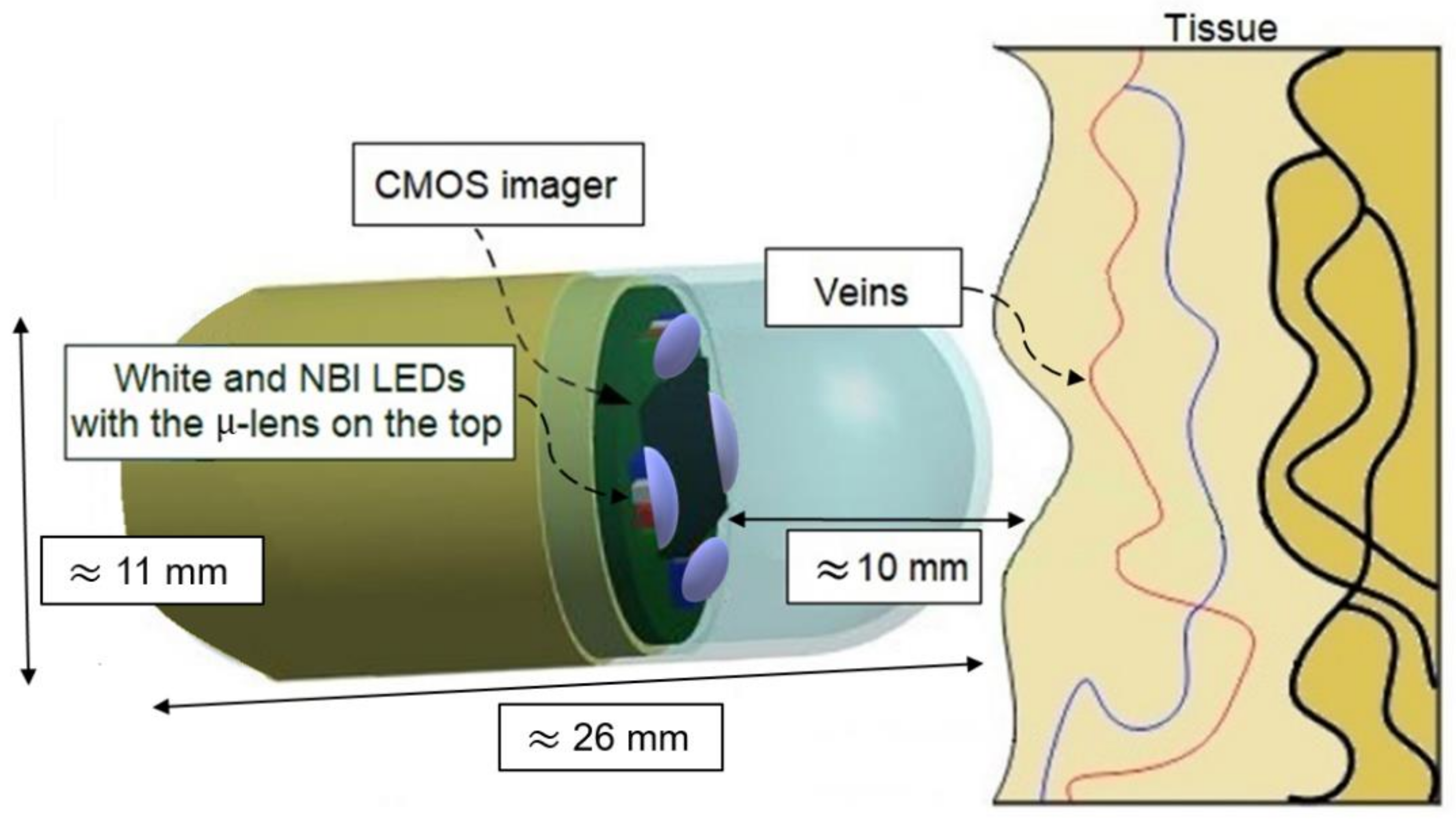
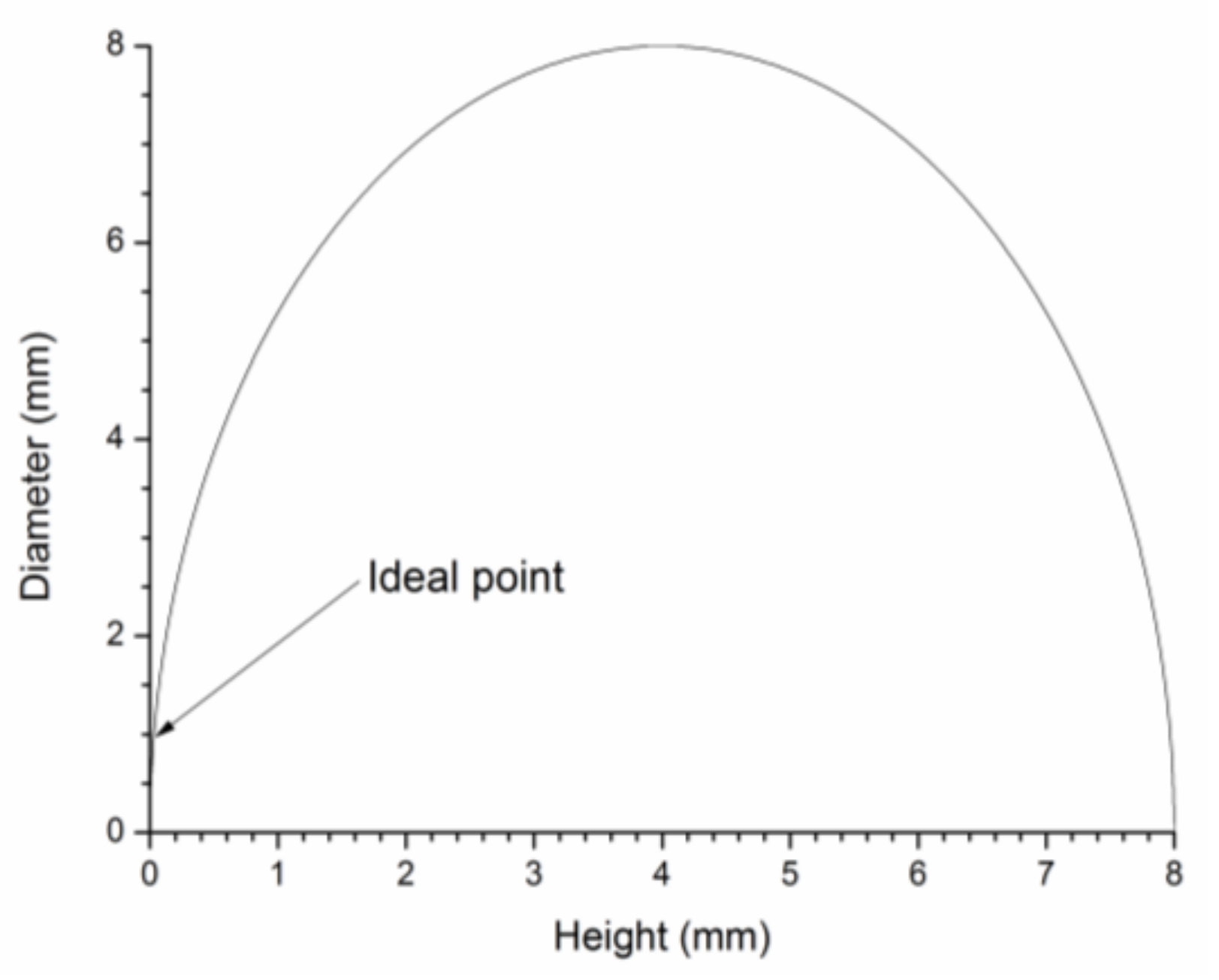
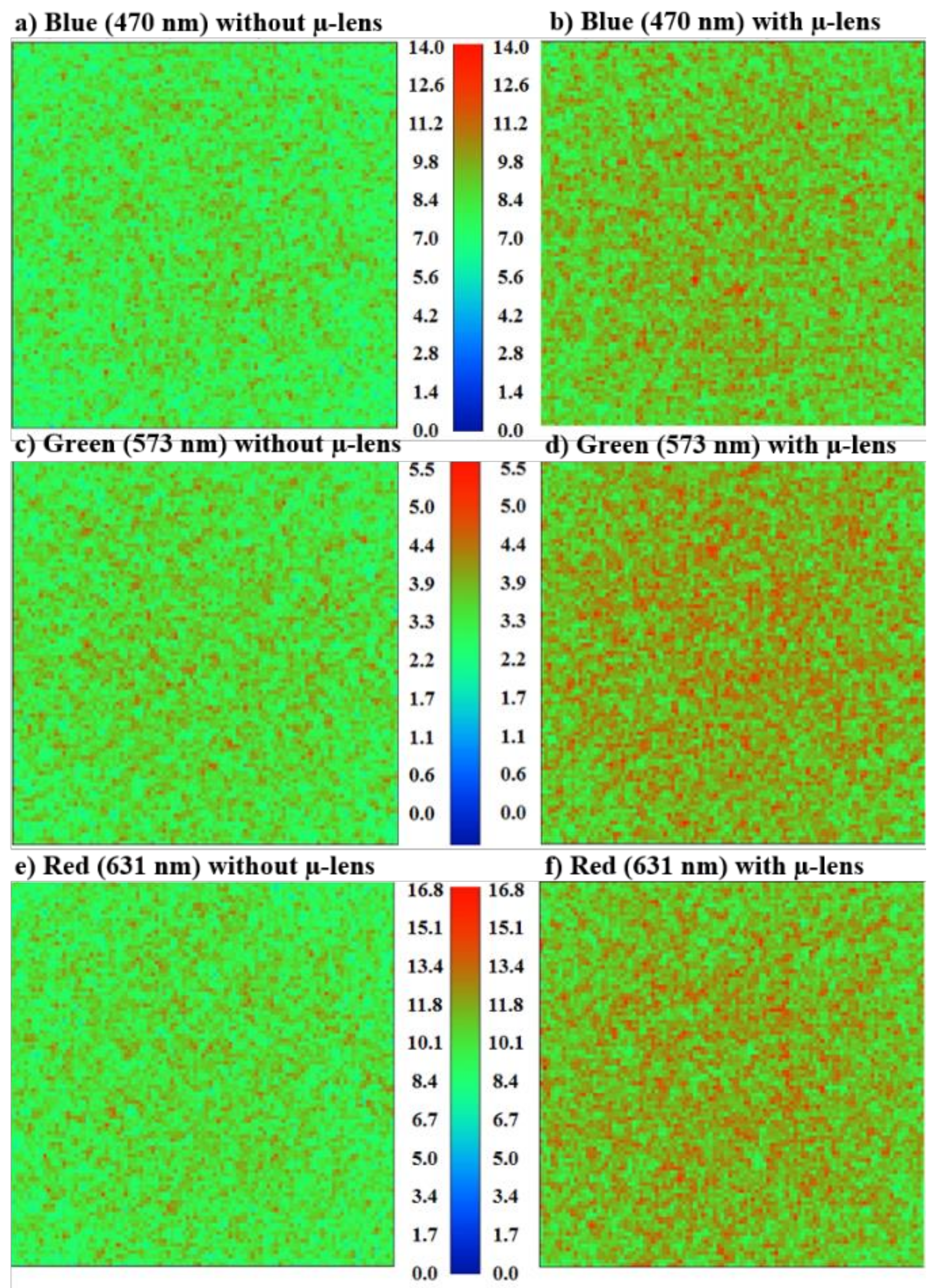

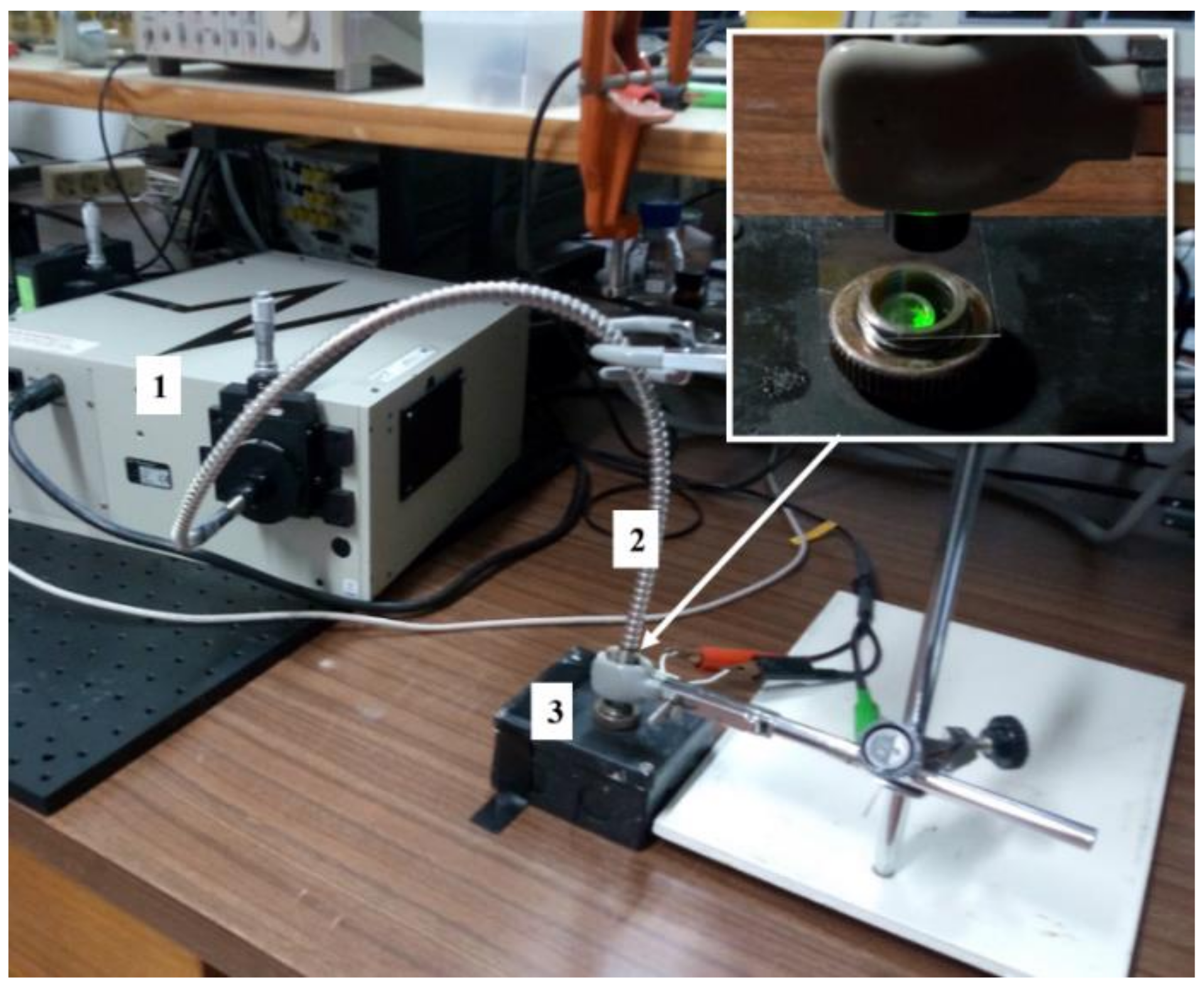

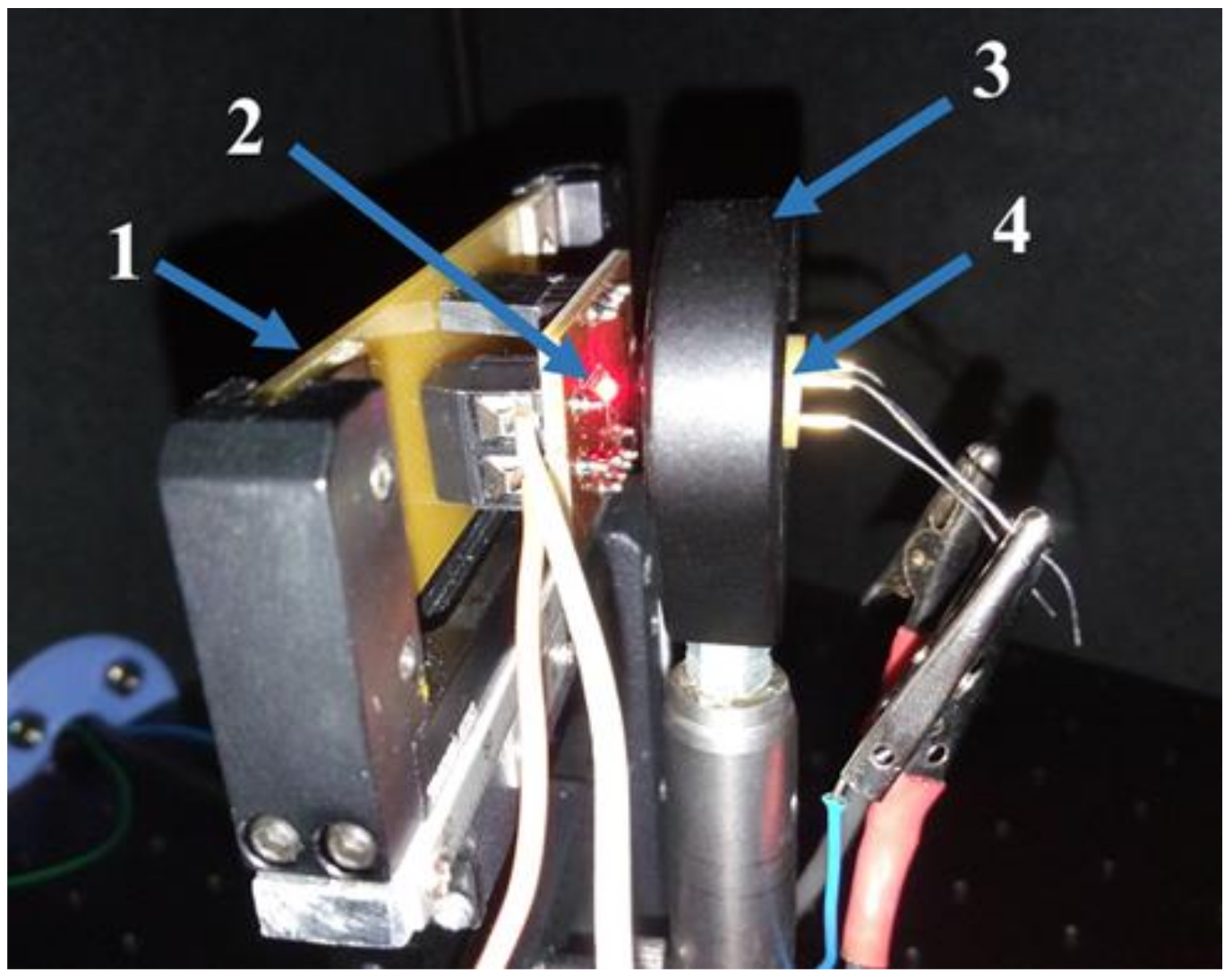
| Surface | Type | Comment | Radius (mm) | Thickness (mm) | Glass | Semi Diameter (mm) | Conic (mm) |
|---|---|---|---|---|---|---|---|
| OBJ | Standard | Optical dome | Infinity | Infinity | - | 0.000 | 0.000 |
| 1 | Standard | Substrate | Infinity | 0.100 | BK7 | 9.000 | 0.000 |
| 2 | Standard | Lens | Infinity | 0.520 | PDMS | 1.950 | 0.000 |
| 3 | Standard | Lens | −3.916 | 0.520 | - | 1.950 | −1.958 |
| STO | Standard | Aperture stop | Infinity | 0.000 | - | 0.000 | 0.000 |
| IMA | Standard | Image sensor | Infinity | - | - | 0.000 | 0.000 |
| Object Type | Power (Watts) | X Half Width (mm) | Y Half Width (mm) | Minimum Angle (°) | Maximum Angle (°) | I(0); I(10); I(20); I(30); I(40) | I(50); I(60); I(70); I(80); I(90) | Wavelength (µm) |
|---|---|---|---|---|---|---|---|---|
| Source Radial | 2.7 × 10−3 | 0.07 | 0.07 | 0 | 90 | 100; 100; 95; 90; 85 | 70; 50; 30; 15; 0 | 0.470 |
| Source Radial | 1 × 10−3 | 0.07 | 0.07 | 0 | 90 | 100; 100; 95; 90; 85 | 70; 50; 30; 15; 0 | 0.573 |
| Source Radial | 3.3 × 10−3 | 0.07 | 0.07 | 0 | 90 | 100; 100; 95; 90; 85 | 70; 50; 30; 15; 0 | 0.631 |
| Optical Analysis | |||||
|---|---|---|---|---|---|
| Wavelength (nm) | 470 | 573 | 631 | ||
| 1.416 | 1.411 | 1.409 | |||
| (mm) | 9.414 | 9.529 | 9.575 | ||
| (mm) | 0.011 | 0.014 | 0.015 | ||
| Irradiance (W/m2) | Without µ-lens | Sim | 11.75 | 4.70 | 14.23 |
| Exp | 0.686 | 1.46 | 5.18 | ||
| With µ-lens | Sim | 13.98 | 5.43 | 16.78 | |
| Exp | 0.832 | 1.76 | 6.12 | ||
| Increase factor | Sim | 1.19 | 1.16 | 1.18 | |
| Exp | 1.21 | 1.21 | 1.18 | ||
© 2019 by the authors. Licensee MDPI, Basel, Switzerland. This article is an open access article distributed under the terms and conditions of the Creative Commons Attribution (CC BY) license (http://creativecommons.org/licenses/by/4.0/).
Share and Cite
Costa, A.C.; Pimenta, S.; Ribeiro, J.F.; Silva, M.F.; Wolffenbuttel, R.F.; Dong, T.; Yang, Z.; Correia, J.H. PDMS Microlenses for Focusing Light in Narrow Band Imaging Diagnostics. Sensors 2019, 19, 1057. https://doi.org/10.3390/s19051057
Costa AC, Pimenta S, Ribeiro JF, Silva MF, Wolffenbuttel RF, Dong T, Yang Z, Correia JH. PDMS Microlenses for Focusing Light in Narrow Band Imaging Diagnostics. Sensors. 2019; 19(5):1057. https://doi.org/10.3390/s19051057
Chicago/Turabian StyleCosta, Adriana C., Sara Pimenta, João F. Ribeiro, Manuel F. Silva, Reinoud F. Wolffenbuttel, Tao Dong, Zhaochu Yang, and José H. Correia. 2019. "PDMS Microlenses for Focusing Light in Narrow Band Imaging Diagnostics" Sensors 19, no. 5: 1057. https://doi.org/10.3390/s19051057
APA StyleCosta, A. C., Pimenta, S., Ribeiro, J. F., Silva, M. F., Wolffenbuttel, R. F., Dong, T., Yang, Z., & Correia, J. H. (2019). PDMS Microlenses for Focusing Light in Narrow Band Imaging Diagnostics. Sensors, 19(5), 1057. https://doi.org/10.3390/s19051057





